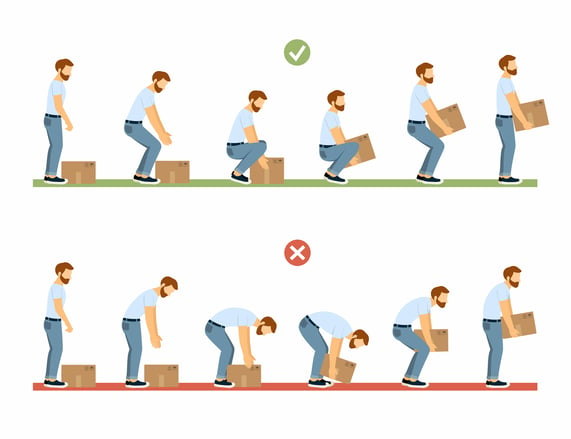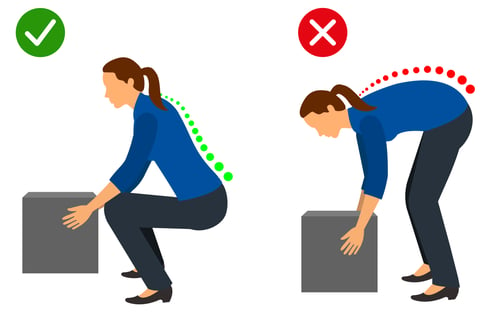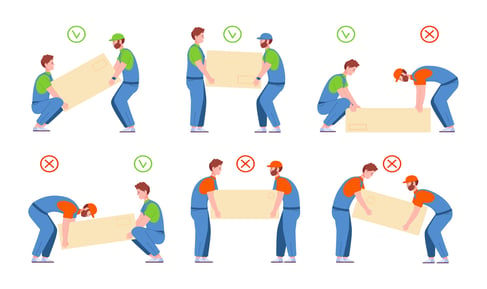Manual handling, the act of lifting, lowering, pushing, pulling, carrying, or holding objects, is an integral part of many jobs and daily activities. While seemingly straightforward, improper manual handling techniques can lead to musculoskeletal disorders (MSDs), pain, and injuries.
This article dives into the essential aspects of safe manual handling, equipping you with the knowledge and techniques to perform these tasks efficiently and safely.
Principles of Safe Lifting
Safe listing techniques are critical, but before you ever pick something up it’s crucial to understand the underlying principles of safe manual handling. Here’s what you should keep in mind:
Plan Your Lift
- Assess the weight, size, and shape of the object before lifting. A heavier object will require more planning and potential assistance. The size and shape of the object will influence your grip and how you approach the lift.
- Clear the path of any obstacles and ensure you have a firm footing. Look around for anything that could trip you or hinder your movement during the lift. Choose a stable, slip-free surface to stand on.
Position Yourself Correctly
- Stand close to the object: This minimizes the distance you need to lift the object and reduces strain on your back.
- Feet shoulder-width apart and one foot slightly forward: This provides a wide and stable base for your body.
- Bend your knees and hips, keeping your back straight and core engaged: This engages your leg muscles, which are stronger than your back muscles, and protects your spine from injury. Imagine you are sitting down rather than bending over at the waist.
Get a Firm Grip
- Use both hands whenever possible: This distributes the weight evenly and provides better control over the object.
- Position your hands close together and as close to your body as possible: This helps maintain control and minimizes leverage that could strain your back.
- Vary your grip depending on the object: For example, use a palms-up grip for flat boxes and a palms-down grip for cylindrical objects.
Lift Smoothly
- Engage your leg muscles to lift the object, keeping your back straight as if you are sitting down. Avoid jerky movements and lift steadily.
- Exhale as you lift: This can help engage your core muscles and stabilize your spine.

Carry Close to Your Body
- Hold the object close to your body throughout the lift and carry. This reduces the strain on your back and arms as the weight is closer to your center of gravity.
- Keep your elbows close to your body while carrying.
Put It Down Safely
- Bend your knees and hips to lower the object gently to the ground. Avoid twisting your back while lowering.
- Follow the same principles as lifting in reverse order.
By following these detailed principles and incorporating them into your daily routine, you can significantly reduce the risk of injuries associated with manual lifting. Remember, prioritizing safe lifting techniques is an investment in your long-term health and well-being.
Manipulating Objects by Hand
Beyond lifting and carrying, many manual handling tasks involve manipulating objects by hand. Here are some key strategies to ensure safety and minimize strain when handling objects by hand:
- Push and pull with your legs: Whenever possible, use your legs and core muscles to push or pull objects. This leverages your stronger muscle groups and reduces strain on your back.
- Maintain proper posture: While pushing or pulling, avoid hunching or twisting your back. Keep your core engaged and maintain a neutral spine, similar to the principles outlined in safe lifting.
- Vary your tasks: Repetitive movements and static postures can lead to fatigue and increase the risk of injury. Take frequent breaks and change positions regularly to prevent muscle strain and discomfort.
- Use proper body mechanics: When reaching for objects, avoid awkward postures and overreaching. Bend your knees and hips to lower yourself instead of bending at the waist.
- Use leverage to your advantage: When possible, use tools or leverage to your advantage to reduce the physical effort required for manipulating objects. For example, use a pry bar to open a tight lid instead of struggling with your hands.
- Mind the weight and size: Be aware of the weight and size of the object you are handling. For heavier or bulkier objects, seek help from colleagues or consider using appropriate lifting aids.
Additional Tips
- Wear appropriate clothing and footwear: Choose clothing that allows for freedom of movement and footwear that provides good traction to prevent slips and falls.
- Stay hydrated: Drinking plenty of water throughout the day helps maintain muscle function and prevent fatigue, which can increase the risk of injury.
- Be mindful of your limitations: Don’t attempt to handle objects that are too heavy, bulky, or awkward for you to manage safely. Know your limits and seek help when necessary.
By incorporating these strategies and remaining mindful of proper body mechanics, you can safely and efficiently manipulate objects by hand, reducing the risk of injuries and promoting long-term musculoskeletal health.
Carrying
Carrying objects is a common manual handling activity, but it’s important to carry them safely to avoid strain and injury. Here are some key principles to remember:
Use Carrying Aids
- Consider using trolleys, carts, or other carrying aids whenever possible, especially for heavy or bulky objects. These tools can significantly reduce the physical strain on your body and help you carry objects more efficiently.
- Choose the appropriate carrying aid for the specific task and object. For instance, a hand truck might be suitable for a box of files, while a dolly might be better suited for a heavy appliance.
Carry Evenly
- Distribute the weight evenly between both arms when carrying objects. This helps maintain your body balance and prevents uneven strain on one side.
- If the object is not evenly balanced, use a carrying aid or seek help from a colleague.
Keep Your Back Straight
- Avoid hunching or twisting your back while carrying. This puts unnecessary strain on your spine and can lead to pain and injury.
- Engage your core muscles to maintain a neutral spine and good posture.

Vary Your Grip and Position
- Change the position of your hands and the way you hold the object periodically. This helps prevent fatigue and muscle strain in specific areas.
- For example, if you’re carrying a box, you can switch between holding it at your side and cradling it in your arms.
Mind Your Route
- Plan your route beforehand and avoid carrying objects through congested areas or over uneven surfaces. This minimizes the risk of tripping or losing your balance.
- Be aware of your surroundings and watch out for obstacles.
Seek Help for Heavy Objects
- Don’t attempt to carry objects that are too heavy or awkward for you to manage safely.
- Ask for help from a colleague or use a carrying aid.
By following these guidelines and prioritizing safe carrying techniques, you can minimize the risk of injury and ensure the safe transport of objects. Remember, safety should always be the top priority when performing any manual handling task.

Proper Training for Manual Handling
Investing in proper manual handling training is crucial for preventing injuries and promoting workplace safety. Training should cover:
- Identifying and assessing manual handling risks
- Safe lifting and carrying techniques
- The importance of proper posture and body mechanics
- The use of personal protective equipment (PPE), if necessary
- How to report unsafe working conditions
Remember:
- Listen to your body: Pay attention to any pain or discomfort and stop the activity if necessary.
- Ask for help: Don’t hesitate to ask for assistance when dealing with heavy or awkward objects.
- Report unsafe practices: If you observe unsafe manual handling practices in your workplace, report them to the appropriate supervisor.
By following these guidelines and prioritizing proper training, you can master the art of safe manual handling and protect yourself from potential injuries. Remember, a healthy and pain-free body is essential for a fulfilling and productive life.
Mastering Manual Handling for a Safe and Healthy You
Manual handling is an unavoidable part of our daily lives, both at work and at home. By prioritizing safe techniques and adopting a mindful approach, we can transform these tasks from potential hazards into manageable activities.
Remember, the key principles outlined in this article – planning your lifts, maintaining proper posture, seeking help for heavy objects, and utilizing proper equipment – are your foundation for safe manual handling.
Incorporating these practices into your routine, along with seeking proper training when necessary, empowers you to protect yourself from injuries and maintain long-term musculoskeletal health. By prioritizing safety and adopting a mindful approach to manual handling, you can ensure a healthy and productive life, free from preventable pain and discomfort.

